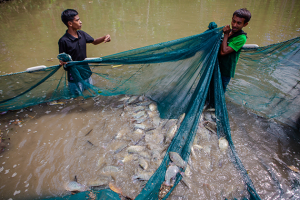
Fish farmers harvest genetically improved farmed tilapia. Credit: Shandy Santos
By Jharendu Pant
PENANG, Malaysia, May 3 2023 – For Timor-Leste, as with most other islands in the Pacific, fortunes are to be found in fish – an equity food available to all regardless of status.
Nevertheless, the island is highly exposed to the impacts of climate change, hampering domestic food production and contributing to Timor-Leste’s ranking of 110th out of 121 countries for malnutrition. Meanwhile, the country is highly dependent on imported foods – including aquatic foods.
But a national strategy to prioritise the sustainable growth of fish production, particularly through farming of Genetically Improved Farmed Tilapia (GIFT), is helping not only to reverse these trends, but also to provide new economic and livelihood opportunities throughout the entire aquaculture value chain.
And its successes offer economies of scale for development agencies and donors looking to maximise impact by replicating the strategy across other Pacific states with similar environments and challenges.

Jharendu Pant
Timor-Leste’s National Aquaculture Development Strategy (NADS) began in 2012 and has taken some years to start yielding results because a lack of infrastructure, resources and know-how meant the model had to be developed from scratch. Now, though, the country is steadily progressing towards building a more sustainable and resilient aquatic food production system.
Timor-Leste is on track to double fish consumption between 2010 and 2030, with all the benefits for improving nutrition this holds, having already generated returns by tripling productivity while reducing culture period by half. Timor-Leste’s farmers are now able to produce more nutritious aquatic food in less time.
The ripple effects of these successes are already spreading in the region: representatives from the Solomon Islands travelled to Timor-Leste for training in 2018 and 2019 to learn from the model, which offers a blueprint for addressing similar challenges faced by other island nations.
Small island developing states (SIDS) are collectively among the countries most affected by malnutrition, with 75 per cent of adult deaths in the Pacific caused by non-communicable disease – many of them diet-related. At the same time, small island states are among the most exposed to climate risk, which impacts the production of nutritious, indigenous foods.
But based on Timor-Leste’s learnings, other small island nations can also boost nutrition security and livelihoods through a similar dedicated strategy for aquaculture.
The approach starts with prioritising and deploying locally adapted solutions and technologies. WorldFish, working together with the Government of Timor-Leste, helped to introduce a public-private partnership (PPP) model for Genetically Improved Farmed Tilapia (GIFT) hatcheries across the country, ensuring that farmers have access to high quality fish fingerlings in their local area.

Senor Robiay, cluster coordinator of Laubonu. Credit: Silvino Gomes
This improved breed of tilapia is ideal for addressing nutrition gaps for protein, essential fatty acids and micronutrients, while also minimising the burden on the environment, due to its relatively lower carbon footprint. The hatcheries were also established following rigorous environmental standards, which limits the release of effluence and observes biosecurity measures.
However, one of the challenges remaining for Timor-Leste and other resource-poor countries is the development of effective regulations and compliance monitoring. Alongside greater capacity for upholding environmental standards, subsequent phases of the strategy would also look to ensuring the benefits of increased production are shared equitably. This includes addressing issues of gender equality as well as youth employment opportunities.
Secondly, other countries with similar contexts can learn from Timor-Leste’s example of prioritising growth in production to drive increased consumption. Timor-Leste’s new fish hatcheries have helped increase production threefold between its first and second phase, paving the way for the successful scaling of aquaculture across the country.
And by prioritizing the production of monosex (all male) tilapia – which grow faster than female tilapia – Timor-Leste’s approach allowed the country’s farmers to maximize growth and the rate at which domestic production could meet the nutrition needs of the population. This resulted in increased availability and accessibility of nutritious fish to support higher levels of consumption.
Finally, Timor-Leste’s commitment to an ongoing aquaculture strategy over a decade and counting has also allowed the initiative to evolve over time. Such a long-term approach has also enabled the testing and validation of technologies and practices, making the scaling and replication elsewhere comparatively straightforward.
But ongoing funding is critical, both to develop the long-term capacity needed to maintain economic and nutritional gains in Timor-Leste, and to jumpstart similar initiatives elsewhere. The Partnership for Aquaculture Development in Timor-Leste (PADTL2) has been funded by the Ministry of Foreign Affairs and Trade (MFAT) New Zealand since 2014, with complementary financing from USAID in recent years, offering more solid and lasting gains than ad hoc interventions that last just a couple of years.
The sustainable growth of aquaculture production offers many benefits for small island nations. Over the last decade, Timor-Leste’s aquaculture strategy has become a model for developing more inclusive and secure food systems for all, helping to combat the challenges of malnutrition and exposure to climate change that impact Pacific Islands.
Partners including WorldFish are standing by to replicate this success and support other island governments to sustainably increase fish production and consumption to unlock blue fortunes for all.
IPS UN Bureau
Excerpt:
Dr. Jharendu Pant is Senior Scientist – Sustainable Aquaculture Program, WorldFish